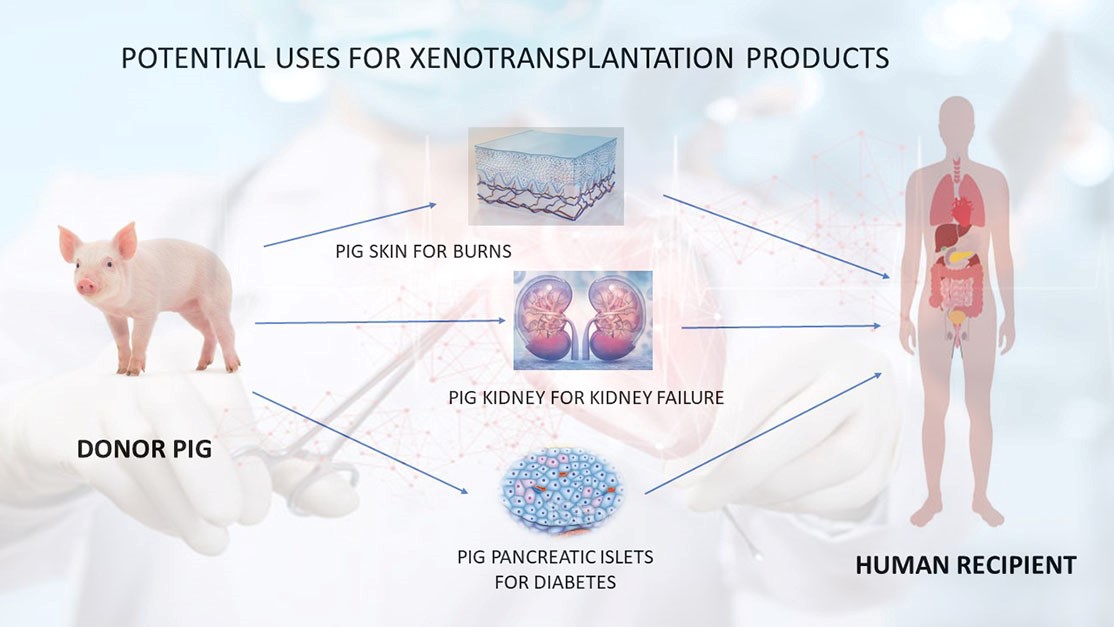FIRST HUMAN RECIPIENT OF PIG KIDNEY TRANSPLANT DIES

Source: FDA
Disclaimer: Copyright infringement not intended.
Context
- The first recipient of a modified pig kidney transplant passed away, around two months after the surgery was carried out.
- The family members and the Massachusetts General Hospital, where the procedure was performed, did not link the transplant operation to his death.
Details
- Xenotransplantation, or heterologous transplant, involves transplanting live cells, tissues, or organs from nonhuman animal sources into human recipients.
- Such cells, tissues or organs are called xenografts or xenotransplants.
- It aims to address the shortage of human organs available for transplantation, providing potential solutions for patients awaiting life-saving procedures.
History and Development
- Xenotransplantation, particularly involving hearts, was first attempted in humans during the 1980s.
- The demand for organ transplants far exceeds the availability of donor organs, leading to lengthy waiting lists and thousands of deaths annually.
- Besides organ transplantation, xenotransplantation shows promise in treating neurodegenerative disorders, diabetes, and other medical conditions using animal cells and tissues.
Challenges
- Immunological Barriers: The risk of rejection remains a significant challenge, as the human immune system may recognize and attack foreign animal tissues or organs.
- Infection Risks: Xenotransplantation raises concerns about potential transmission of infectious diseases or zoonotic infections from animals to humans.
- Long-Term Outcomes: Limited data on the long-term effects and success rates of xenotransplantation procedures underscore the need for further research and clinical trials.
- Animal Welfare: Ethical concerns surround the use of animals as organ donors and the potential impact on their welfare.
Xenotransplantation Process
Preparing the Organ:
- Genetic Modification: The selected animal organ undergoes genetic modifications to reduce the risk of rejection by the human immune system.
- CRISPR-Cas9 Technology: CRISPR-Cas9 is utilized to remove pig genes that produce antibodies and incorporate human genes to enhance compatibility.
- Enhancing Compatibility: Specific genetic edits aim to make the organ more compatible with human physiology and immune response.
Surgical Procedure:
- Transplantation Surgery: The modified pig organ is surgically implanted into the recipient's body, similar to a standard organ transplant procedure.
- Immune-Suppressing Drugs: Post-surgery, recipients receive immune-suppressing medications to prevent rejection and allow for successful integration of the transplanted organ.
Monitoring and Follow-Up:
- Continuous Monitoring: Close monitoring of the recipient's immune response and organ function is essential post-transplantation.
- Response Evaluation: Regular assessments are conducted to evaluate the body's response to the transplanted organ and ensure its continued viability.
Why Pigs for Xenotransplantation?
- Anatomical and Physiological Similarity: Pigs share anatomical and physiological similarities with humans, making them suitable candidates for xenotransplantation.
- Cost-Effectiveness: Pigs are widely farmed, and breeding them for organ transplantation is cost-effective compared to other animal species.
- Variety of Breeds: The availability of various pig breeds allows for matching organ sizes with recipient needs, increasing compatibility.
Addressing Immune Rejection:
- Thymus Gland Embedding: Embedding the pig's thymus gland beneath the organ's outer layer helps educate the recipient's immune system, reducing immune responses.
- Immunosuppression Management: Proper management of immune-suppressing medications is crucial to prevent rejection and ensure long-term organ function.
Types of Xenotransplants
- Solid Organ Transplants: Involves transplanting whole organs, such as hearts, kidneys, livers, or lungs, from animals to humans.
- Cellular Xenotransplants: Involves transplanting specific cells or tissues, such as pancreatic islet cells for diabetes treatment or neuronal cells for neurodegenerative diseases.
- Genetically Engineered Xenotransplants: Animals may be genetically modified to reduce the risk of rejection by the recipient's immune system or to enhance compatibility.
Sources:
|
PRACTICE QUESTION Q. Xenotransplantation holds promise as a potential solution to the shortage of human organs for transplantation, offering the prospect of life-saving treatments for patients with end-stage organ failure. Critically analyse. (150 words) |




1.png)
